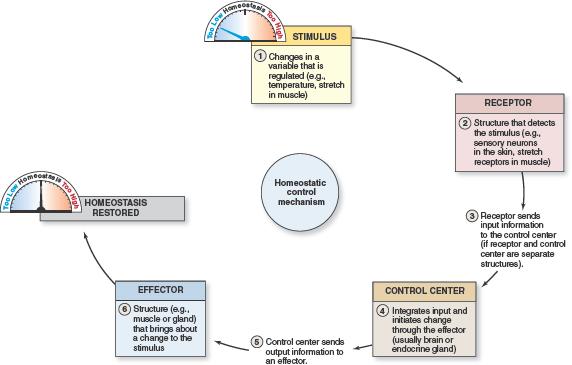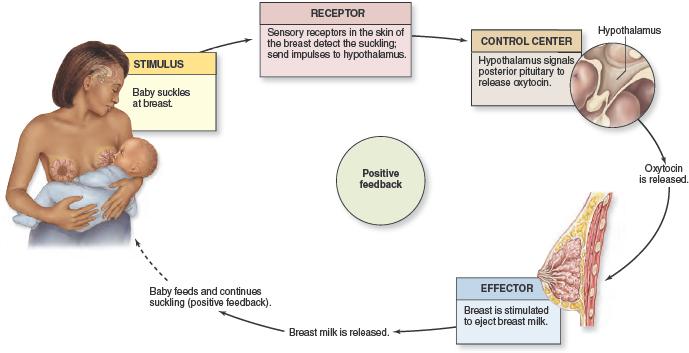What happens when it is hot outside to your body temperature of 98.6 F? Does it change?
NO
Easy way to learn homeostasis.
Homoios = similar
Stasis = Standing
Or steady state
What is homeostasis?
The body’s ability to maintain a relatively stable internal environment in response to changing conditions
Maintain a consistent internal environment
How does the body maintain homeostasis?
By using homeostatic control systems
What 3 components are associated with each homeostatic control system?
1. Receptor
2. Control Center
3. Effector
What does homeostasis look like?

A homeostatic control mechanism consists of a receptor (detects a stimulus), a control center (integrates input and initiates change through the effector), and an effector (brings about a change in response to the stimulus).
What is a receptor?
The structure that detects changes in a variable, the stimulus
Ex: A change in temperature
Consists of sensory nerves (nerve cells)
What is a stimulus? Give an example?
A change in the variable (physical or chemical factor)
Ex: Change in light
Retina of eye (receptor) detects a change in light (stimulus) entering the eye
What is the control center, what does it do?
–The structure that interprets input from the receptor
–Initiates changes through the effector
–
What portion of the body is the control center a part of?
A portion of the nervous system or an endocrine organ
- Nervous system can provide a quicker response
–e.g., regulation of blood pressure upon rising
- Endocrine response is more sustained
- Side note: This means that it may take several hours or days for hormone release
–e.g., parathyroid hormone regulating calcium levels
Why is the control center sometimes in the same structure as the receptor?
It both detects the stimulus and causes a response to regulate it
Ex: Pancreas (receptor) detects increase in blood glucose and acts as a control center to release the hormone insulin in response
What is an effector? Give an example (teachers like you to know these things)
–The structure that brings about change to alter the stimulus
–Most body structures
- Most common effectors are muscles or glands
Ex: Smooth muscle in the walls of air passageways (bronchioles) regulate airflow into and out of the lungs
EX: Glands such as the pancreas release hormones (insulin)
How does the response of a homeostatic system occur?
Occurs through a feedback loop
What happens in a feedback loop?
–stimulus
–detection of stimulus by a receptor
–information relayed to the control center
–integration of the input by control center and initiation of change through effectors
–return of homeostasis by the actions of effectors
List and describe the 3 components of a homeostatic system.
The receptor detects changes in a variable
The control center interprets input and initiates change through the effector, which brings about changes to alter the stimulus
What are the two broad categoris involved with the homeostatic control systems?
Negative and positive feedback
Most processes in the body are controlled by ________ feedback.
Negative
Describe negative feedback.
–A type of homeostatic control system that maintains the variable within a normal range
–Resulting action in the opposite direction of stimulus
–Controls most processes in the body
–Variable maintained within a normal level, its set point
- fluctuates around the set point
If stimulus increases, homeostatic control system activated to cause a ______ in the stimulus
Decrease
If stimulus decreases, homeostatic control system activated to cause an _____ in the stimulus
Increase
Describe temperature regulation
–Body temperature drops
–Sensory receptors detect this and signal the hypothalamus (component of the brain)
–Hypothalamus alerts nerve impulses in blood vessels in the skin to decrease the inside opening of the vessels
–This decreases amount of amount of blood circulating to the surface of the body
–Less heat is released through skin
–Nerve impulses are sent to skeletal muscles, causing shivering
–Nerve impulses are sent to smooth muscles of hair follicles, causing “goosebumps”
Temperature regulation what else do you know?
–Body temperature rises
–Sensory receptors detect this and signal the hypothalamus
–Hypothalamus alerts nerve impulses in blood vessels in the skin to increase the inside opening of the vessels
–This increases the amount of blood circulating to the body surface
–More heat is released through skin
What are other examples of homeostatic regulation?
–withdrawal reflex in response to injury
–regulating heart rate and blood pressure during exercise
–changing breathing rate in response to increased carbon dioxide
–parathyroid hormone release in response to decreased calcium
–release of insulin by the pancreas in response to increased blood glucose
Describe positive feedback.
–Moves the stimulus in the same direction
–Continues until a climatic event occurs
–Occurs less frequently than negative feedback
Describe positive feedback during breastfeeding.

–Sensory detectors detect baby suckling
–Message is transmitted to the hypothalamus
–Hypothalamus signals posterior pituitary to release the hormone oxytocin
–Oxytocin stimulates the mammary gland to eject breast milk
–Cycle repeats as long as the baby suckles
What are other examples of positive feedback?
Blood clotting cascade
Uterine contractions of labor
Give a summary of homeostatic system characteristics.
–they are dynamic
–the control center is generally the nervous system or endocrine system
–they have three components: receptor, control center, and effector
–they are typically regulated through negative feedback
–it is when these systems fail that a homeostatic imbalance or disease results
What is an example of homeostatic imbalance and what happens?
Diabetes
–Occurs when homeostatic mechanisms for regulating blood glucose are not functioning normally
–Blood glucose fluctuations and high glucose readings
Treating patients invoves finding a diagnosis, a specific cause of _______.
Homeostatic Imbalance
- Most medications have benefits and side effects
–Many can be explained by examining homeostatic mechanisms
How might drugs affect normal homeostatic control mechanisms (SSRI's)?
–SSRI drugs block the reuptake of serotonin into nerve cells in the brain, prolonging its effects
–Patients with depression may have lower levels of serotonin
–Drugs help elevate the mood of patients with depression
–Serotonin is also used in the nerve cells of the digestive system
–Digestive system becomes more excitable due to drug
–Symptoms such as nausea and upset stomach can occur